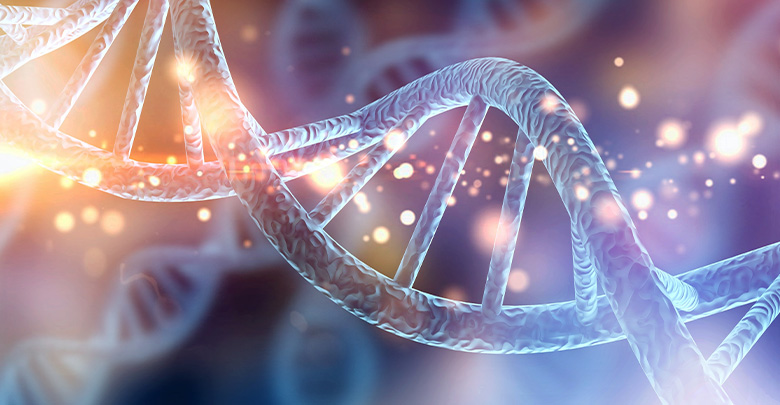Genetics & Type 2 Diabetes: Can you prevent diabetes if it runs in your family?
Genetic predisposition for type 2 diabetes is real but you can control your disease onset and progression with better diet and activity choices

Mainstream media tells us that most people with type 2 diabetes either “caused it themselves” by overeating and gaining weight or they have some have a genetic predisposition to gaining weight.
So what’s the truth about type 2 diabetes and genetics?
Diabetes expert Ruth Ann Crouse, RMA, RDN is passionate about the genetic science behind type 2 diabetes and the impact behavior change can have on a person’s risk of developing the disease.
Science confirms a genetic predisposition for type 2 diabetes
“Research studies show a 40 percent increased risk of developing type 2 diabetes for individuals who have one parent with the disease and up to a 70 percent increased risk if both parents are affected.”
The genetic component for type 2 diabetes is a combination of genetics related to weight and other aspects of the disease, including insulin secretion and insulin resistance, explains Crouse.
“For example, there is a well-known gene called FTO, which has been widely studied for its impact on body weight.”
What’s especially challenging, however, is that even if a person’s body weight is normal, this FTO gene still increases a patient’s risk of type 2 diabetes.
“Unfortunately, genetic science hasn’t identified the mechanism(s) by which FTO and many other genetic variants increase the risk for diabetes, so we really can’t infer ‘the how’ right now.”
Genes that impact insulin secretion when combined with a high-fat diet
“Another gene called TCF7L2 has also been implicated in type 2 diabetes,” explains Crouse. “One variant commonly referred to as ‘rs7903146’ was found to be associated with decreased insulin secretion when individuals were given an oral glucose solution.”
The particularly fascinating detail about rs7903146 is that when combined with a diet high in saturated fat, it can lead to increased levels of insulin resistance.
This means it’s providing a double-whammy that leads to type 2 diabetes: decreased insulin secretion and increased insulin resistance.
While recent research has tried to repair the reputation of saturated fat, patients with gene TCF7L2 and variant rs7903146 would clearly benefit from following a diet low in saturated fat.
Of course, the trickiest part for the average person with diabetes is that you don’t know what genes and variants are part of your makeup. And having your genes tested isn’t simple or easy, or even necessarily possible.
Can better lifestyle habits protect you if your parents have type 2 diabetes?
“As with most chronic diseases like type 2 diabetes, genetics + environment = outcome,” explains Crouse.
A person’s genetic predisposition to developing type 2 diabetes is compounded significantly by their lifestyle: how much physical activity they get, and what they eat.
“Although there is a genetic component to type 2 diabetes, diet and lifestyle are equally impactful on whether or not someone develops the disease,” explains Crouse.
“People have had the FTO and TCF7L2 genes for a long time; long before we saw a sharp increase in diabetes in the last two decades. This points to diet and lifestyle as pivotal causes in the recent rapid increase in type 2 diabetes.”
“There are many people who are at increased risk for diabetes genetically speaking, but they have mitigated the risk with a healthy diet and lifestyle.”
Diabetes is not your destiny just because of a genetic predisposition,” emphasizes Crouse. “I cannot overemphasize the power of diet and lifestyle in mitigating genetic risk related to type 2 diabetes.”
Even if you can’t lose weight, healthy habits make a big difference
The term “big-boned” certainly has its place. Just as some families tend to all be thin, no matter what they eat, other families tend to be thicker. It’s important to understand that your habits still matter without regard to what shape you are.
From my years of working with individuals who have a higher genetic risk for type 2 diabetes, the impact of dietary changes and exercise can be incredibly powerful even if there is no weight loss,” says Crouse.
“Most times, those better habits lead to at least some weight loss, but I have seen instances where the overall diet quality goes from mostly fast food (high-fat, high amounts of refined carbs) to a more whole-food type diet. These patients’ fasting insulin and blood sugar levels improve.”
Case study on the impact of environment
Crouse points to an excerpt from an in-depth study, The Genetic Landscape of Diabetes:
“The number of cases rises when there is a rise in environmental risk (abundant food supplies, lack of activity) and decreases when the number of susceptible individuals falls (by deaths from the complications of diabetes).”
“The classic example of an epidemic of diabetes is found on a remote island in the Pacific Ocean, the island of Nauru. Before the turn of the 20th century, the lifestyle of Nauruans was harsh. The soil was poor, agriculture was difficult, and frequent episodes of starvation were common. Despite these adverse conditions, the islanders were noted to be ‘heavy’. In 1922, it was discovered that Nauru contained phosphate rock, which was then mined for use in fertilizer, and for which the islanders received royalties.”
“Over several decades, the Nauruans became extremely wealthy, and with their new-found riches came major lifestyle changes. Food had become abundant and could be bought from stores. Instead of fishing and farming, Nauruans now led sedentary lives. By the 1950s, type 2 diabetes exploded from being non-existent in this population to affecting 2 of 3 adults over the age of 55 and becoming a common cause of death.”
Take-home message
The take-home message here is that, no matter what, our habits do matter.
- What do we eat?
- How often do we move?
- How much sleep do we get?
- How much alcohol do we drink?
- Do we smoke cigarettes?
- How much soda do we consume?
Every choice we make around these lifestyle habits matters.




